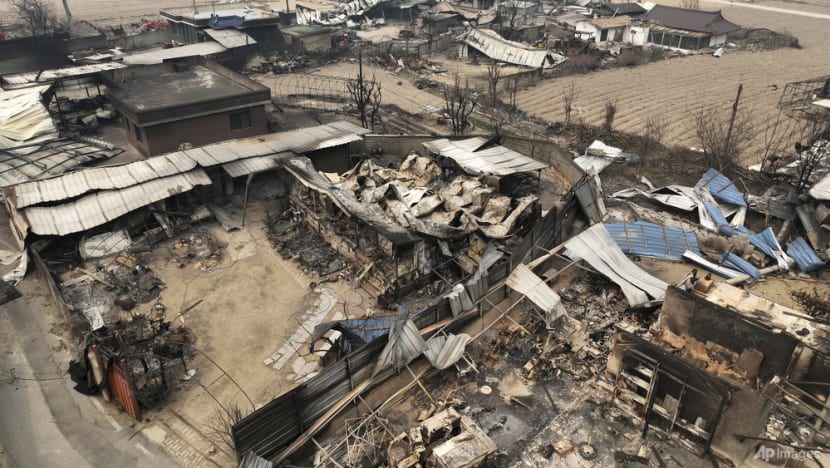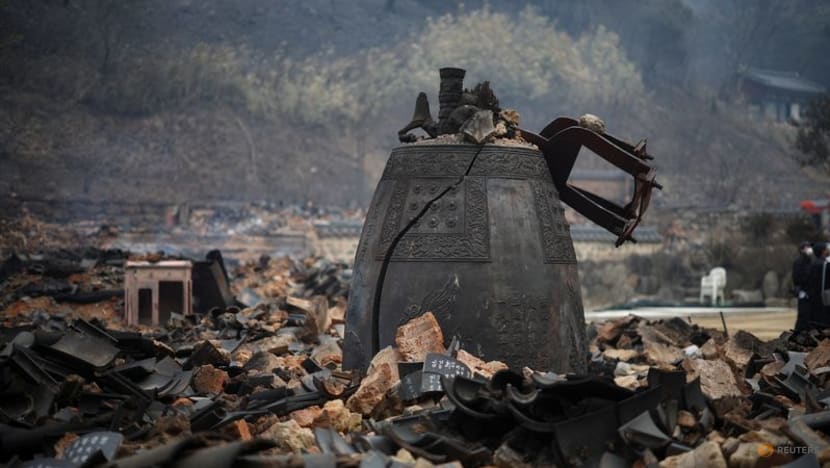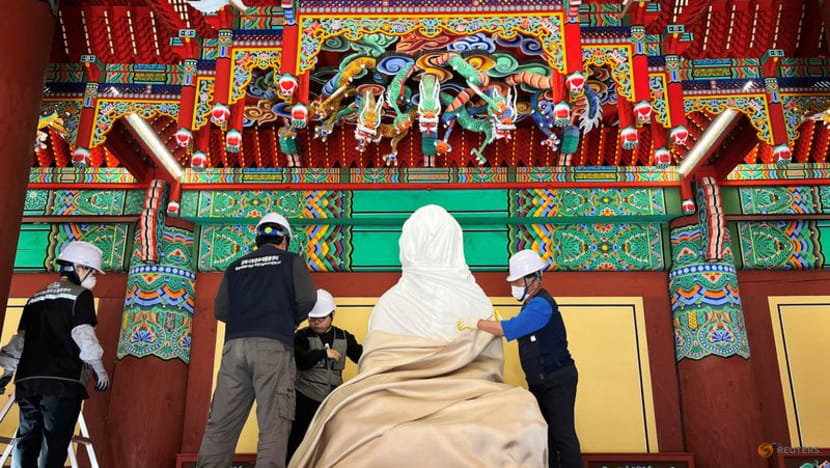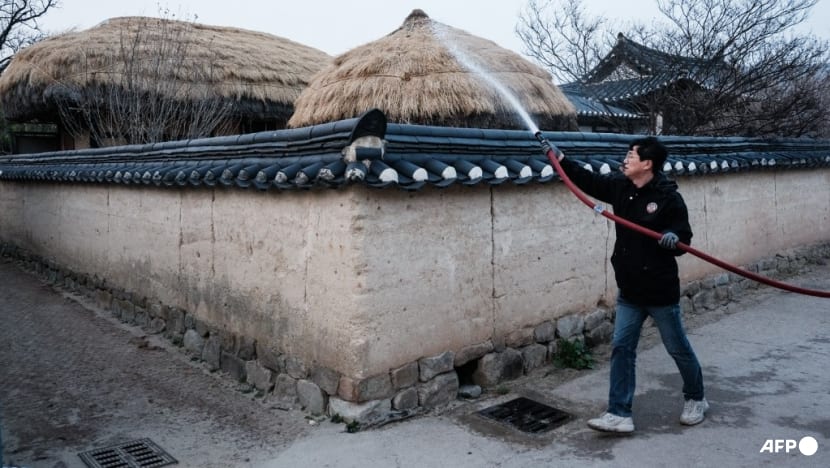'I can only cry': Homes, cultural heritage sites destroyed in South Korea's deadliest wildfires on record
Thousands have been displaced and 28 people died in the fires that broke out last week, with at least 18 designated heritage sites or objects being destroyed or damaged.

Burnt-out houses and warehouses in a destroyed village are seen in Andong, South Korea, Mar 27, 2025. (Photo: AP/Yonhap/Kim Do-hun)

This audio is generated by an AI tool.
ANDONG, South Korea: Kim Dal-geun has lived in Andong for the past decade with his wife, enjoying the rich culture and folk traditions that the city has to offer.
But on Tuesday (Mar 25), the couple was forced to flee with just the clothes on their backs.
They had been ordered to evacuate when South Korea’s worst wildfires on record – which have ravaged much of North Geyeongsang province in the southeast since last week – tore through their city, which is now one of the hardest-hit areas.
The fires began in central Uiseong county and have killed at least 28 people, devastating an area equivalent to about two-thirds of Singapore.
Heritage sites went up in flames, including a 1,300-year-old Buddhist temple, and residents were combing through their burnt homes to see what could be salvaged.
"The fire started down across the road. It was very windy that day, and a fireball blew over … so we started running. People who arrived later said that the fire had started and spread,” Kim told CNA.
The 78-year-old and his wife left the temporary shelters they had been evacuated to and briefly returned to their neighbourhood along with other residents on Thursday to check on their homes.
While part of the couple’s house went up in flames, they were hoping to save anything they could – like a small plot of land where they used to grow chillies for a living.
“This is painful to see, but what can we do? What can we say? It's hard to describe,” Kim added sombrely.
Still, he was relieved that his two dogs were safe and sound after he had to leave them behind. Others may not have been so fortunate – some residents had no time to even remove their dogs’ leashes before fleeing.
1,000-YEAR-OLD TEMPLE DAMAGED
On Friday, Lim Sang-seoup, the minister of the Korea Forest Service, said the main blazes in five regions were now under control and firefighters have switched to controlling small ones.
Light overnight rain helped improve visibility on Friday and slowed down the strong winds that hampered firefighting.
More than 120 helicopters were trying to put out the flames, while firefighters were working non-stop amid concerns that the weather conditions could quickly change against them.
Tens of thousands of people have been evacuated to temporary shelters set up in several areas around mountainous North Gyeongsang.
Apart from the homes and land that the fires have damaged, many cultural assets have also been destroyed.
These include the Gounsa temple in Uiseong. Only nine out of 30 structures at the temple, which has been around for more than a millennium, remain standing, with the rest – including two national treasures – charred by the fires.
Several other treasures like a stone Buddha statue were relocated to other temples around the area.

Gounsa was one of at least 18 designated heritage sites or objects that had been destroyed or damaged as of Thursday, according to the Korea Heritage Service.
Firefighters have remained at the temple to ensure that it stays fire-free, as authorities press on in trying to save as many of its other national heritage sites as possible.
CLIMATE CHANGE FANNED THE FLAMES
National Assembly Speaker Woo Won-shik visited Gounsa on Friday afternoon where he was shown the damage.
He told CNA it was heartbreaking to see what had become of the temple, which was the pride of many South Koreans.
"Due to the climate crisis, weather conditions have changed, causing a massive fire, which we never imagined before,” he noted.
“This incident made me think that first, South Korea needs to establish proper legal and institutional measures to effectively respond to such fires caused by the climate crisis. Also … we need to manage the site well to prevent such incidents from happening again.”
Woo also thanked the public and firefighters for risking their lives to preserve the heritage site, and said he hopes the National Assembly will work with the government to quickly improve systems so that such incidents will not happen again.
“I also believe it is important to provide thorough support – so that not only Gounsa, but also the victims here, can return to their daily lives,” he said.

The temple’s cultural director Beom Jong said he felt an “indescribable feeling of devastation” looking at what was left of it.
“The damage to the 1,000-year-old temple and the headquarters of the religious community is unimaginable,” he added.
“This is the first time in the history of our order that the headquarters has been affected by a fire like this, so we’re now discussing how to respond to this situation.”
Before the blaze, Gounsa Temple had about 120,000 visitors every year, like devotee Jin Yeo-shin who has frequented the temple for about 40 years.
The 82-year-old said words could not express how she felt about the damage.
“It’s heartbreaking, and I can only cry,” she said.
“BEYOND ANYTHING WE COULD HAVE IMAGINED”
In Andong, evacuation orders were also issued for residents of Hahoe Folk Village – a UNESCO World Heritage Site and cultural treasure that has been around for more than 500 years.

"This recent fire is beyond anything we could have imagined and the extent of it is huge,” said Ryu Han Pae, who has lived in the village since he was born in 1949.
“The authorities have done a very careful job in fulfilling their roles, so things have been going well. Overall, the cooperation between the residents and the administration has been working well, and I have a positive outlook on how we have responded so far,” he added.
The elderly man left the village on Wednesday evening following evacuation orders.
“There is a sense of pride as a resident of the village and a belief that it must be preserved. But it’s really heartbreaking that it was/is affected by the fire,” he added.
“My hope, at the end of my life, is that something like this never happens again.”


















